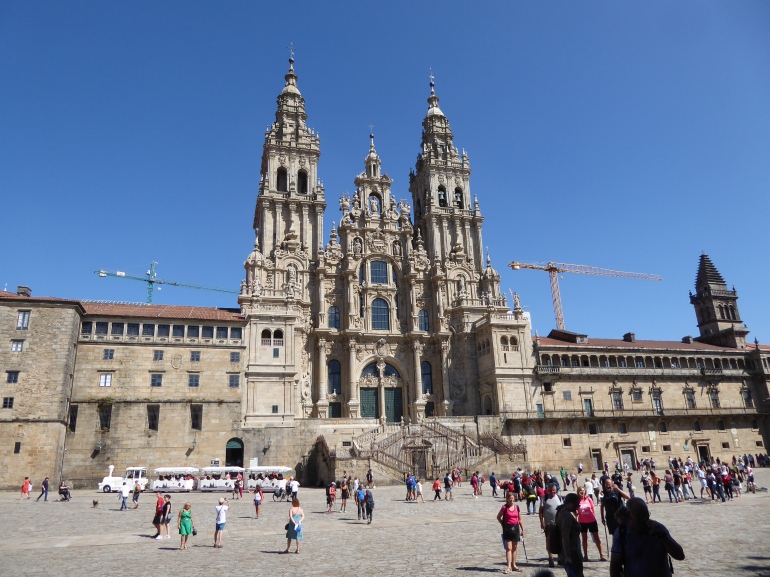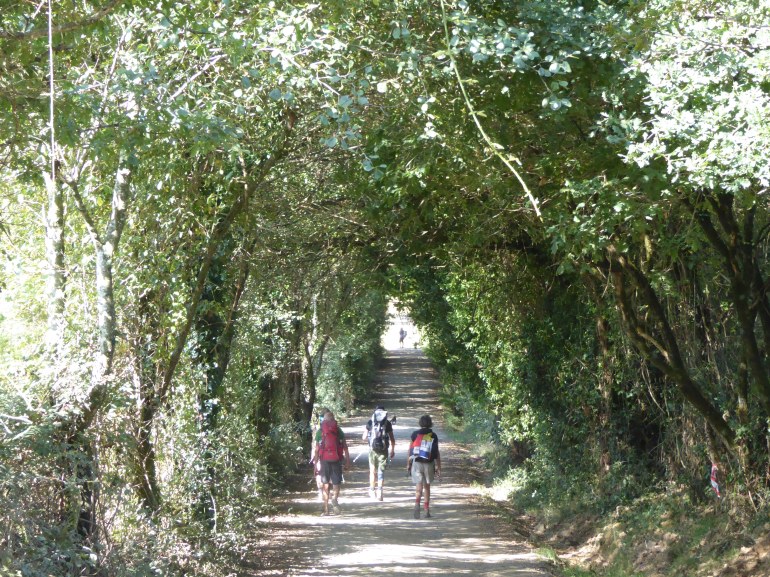
I had not previously heard the account that put St James as Jesus’ cousin. In the tradition in Santiago de Compostela, his mother Salome, was the Virgin Mary’s sister. This tradition makes Jesus more human, less divine and therefore, also just more believable. Santiago de Compostela is the third most important sacred site in Christendom, after Jerusalem and Rome. The Cathedral is built on the site of St James’ grave.
It is said that St James travelled to the Iberian Peninsula in the first century to spread the Word of God and after his execution in 44 A.D., in Jerusalem, by Herod Agrippa, his body was returned to Galicia by his friends and companions for burial. His grave was re-discovered in the 8th century in order to become the focal point of resistance against the Moorish occupation of Christendom, and specifically of Spain and Portugal. Since then, the Camino de Peregrino has become a tradition, over a 1000-years of pilgrimage to venerate St James, the patron saint of pilgrims.

The Camino or The Way in English, has at least three meanings: there is the material, real route, that pilgrims walk to Santiago de Compostela. We walked a mere fraction of the full length, leading from the Pyrenees in France to Santiago. We started early at 9 a.m. from Arzua. Our route was a relatively flat, undulating course of about 10 miles, through open countryside, with grazing fields, cultivated maize, eucalyptus trees, and some pine in the distance. It was a dusty trail and stony in parts, the heat rising to 29 degrees Celsius by midday.
Then, there were the other wayfarers, a Brazilian, a Norwegian, a Czech, a Mauritian by way of Brentwood, two Dutch, an American, an Indian woman from San Diego, a British, and a Nigerian. Here, like a river coursing and flowing, mixing as it snaked and headed for the sea, perhaps even for the Holy See.
Then, there was The Way, the inner, unprompted meanderings of the mind as it butted against the realities of a harsh and corrupt world, of the quickening towards sin by World leaders, the inevitable war and famine and drought (metaphorical and true too).
I thought of my father walking from Ikole-Ekiti, through Oye, and Ifaki, to Agidimo, 30 miles, twice weekly, for an education. How fit he must have been, to walk without blinking, 60 miles every week. That was a different kind of way, nominally thought of as an odyssey or sometimes as being like Jason of the Argonauts and the seeking after the Golden Fleece. That stretch of 30 miles being symbolic of a quest, a journey, on a road or path. Whatever, knocks life brought were merely temporary setbacks.

The Way has this effect, this quality of shrinking everything to the mere act of walking, lifting one foot and placing it ahead of the other. Swinging the arms and feeling the lower back, the sharp impact of each step. The easy awareness of discomfort, then the organicity and spontaneity of movement. This is what being present to the self is, being present to the moment, being instantiated in the act of walking.

The Camino Peregrino attracts, like a magnet, varying motivations, iron filings shaped as a starburst, focused exclusively on Santiago de Compostela. There are those for whom it is an extreme sport, like an ultramarathon, walking 1000-kilometres for months and others for whom, it Is a separation from the obsessive and corrosive consumption of modern life, a turning to monasteries, to the spiritual, if even for a brief period.
For us, it was an interlude on a free Friday before a conference. Yet, it was liberating and enriching. A revelation of how to live, aiming for something, how to follow a path, unfaltering and undeterred. Also, how to attend to the physical world, to the self-in-action, what is now called ‘embodiment’. Finally, how to be attentive to inner life.
Finally, there was ‘The Way’, the revealed road to salvation of which the route was simply a token. The exclusiveness and strictures attendant on such a belief was not to my fancy.

Photos by Jan Oyebode






Exquisitely written thoughts on a powerful and deeply meaningful experience. Beautiful and emotive photography as always. Your talents complement each other’s.
Beautifully and expressively written thoughts on the meaning of pilgrimage. To walk long distances is something our ancient ancestors, the supernomads to walked to fill the world from their African homelands, knew well. As always, the photographs are superb.
Carolyn
Thanks as always for your encouraging and kind words. Always appreciated.
Femi